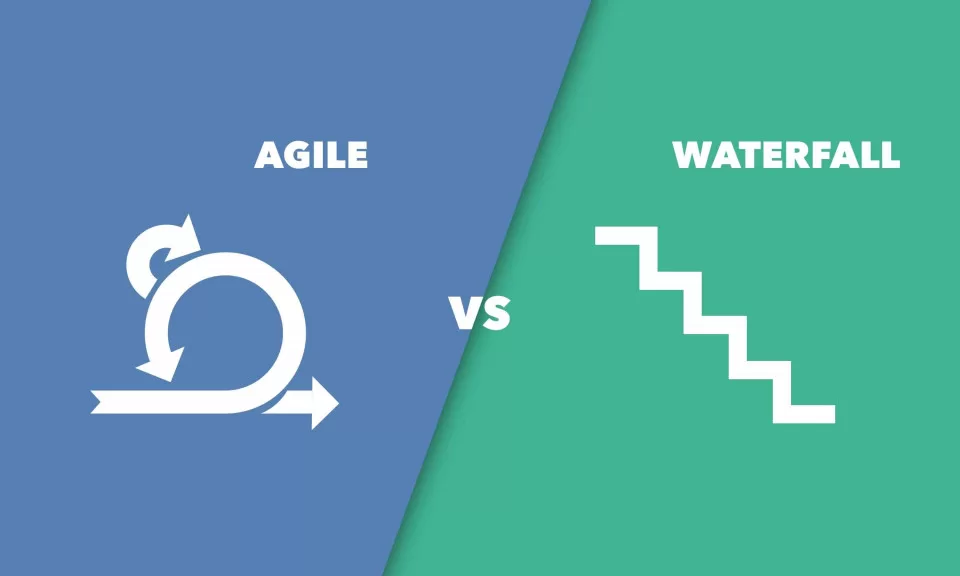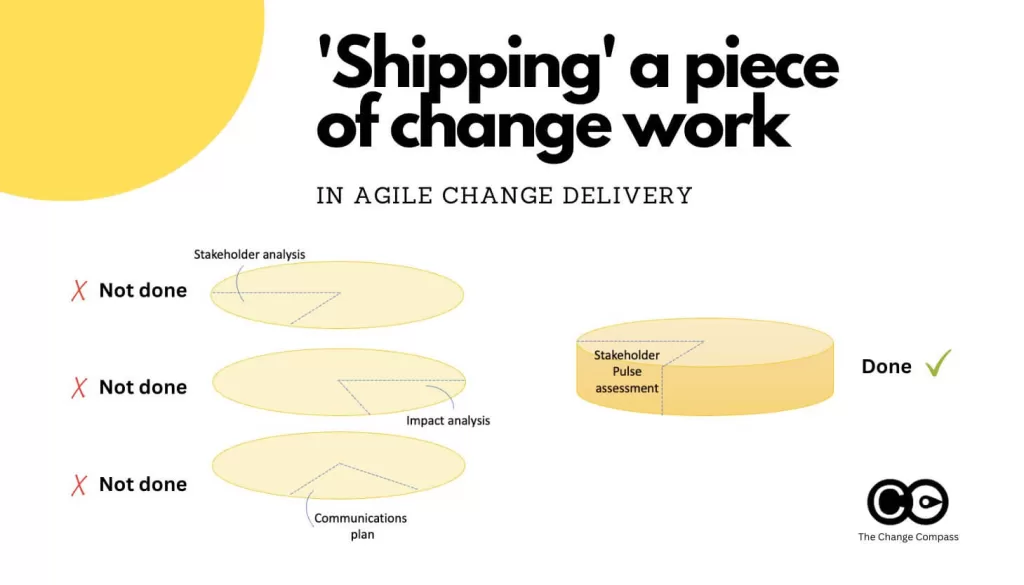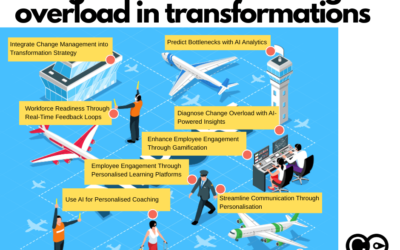Change management methodologies are designed to facilitate the process of implementing organizational changes effectively. However, a lot of traditional change management approaches tend to be too rigid and waterfall-like, hindering organizations from embracing agility. Despite the fact that most organisations are using agile methodology to implement change, methodologies have not kept up to date.
Waterfall vs. Agile: The Need for Change
The waterfall model, characterized by a sequential and linear approach to project management, has long been the dominant framework for managing change in organizations. It follows a structured path, where each phase is completed before moving on to the next. While this approach has its merits, it often falls short when it comes to change management, which requires flexibility and adaptability.
Agile methodologies, on the other hand, emphasize iterative and incremental development, promoting collaboration, continuous improvement, and rapid response to change. Agile has gained significant popularity in software development, but its principles can be applied to change management as well. By embracing agility, organizations can navigate the complexities of change more effectively, fostering innovation and resilience.
Unfortunately, change management work and activities have not been formally acknowledged in agile methodology. To read up more about this visit our article Why Change Management is Omitted from Agile Methodology.
Most change management methodologies, despite the need for agility and adaptability, often retain a waterfall-like structure. Let’s delve into each phase to understand how this traditional approach persists.
- Scoping: In the scoping phase, the change management team typically focuses on defining the scope of the change initiative. However, this phase tends to follow a waterfall approach, where the scope is predetermined and set at the beginning of the project. There is limited room for flexibility or adjustments based on evolving requirements or stakeholder feedback.
- Stakeholder analysis: In traditional change management methodologies, stakeholder analysis is often conducted early on in the process. However, this analysis is frequently treated as a one-time activity, with limited opportunities for ongoing engagement and collaboration with stakeholders. This lack of continuous involvement hampers the ability to incorporate diverse perspectives and adapt the change strategy accordingly.
- Impact analysis: Impact analysis aims to assess the potential consequences of the proposed change on various aspects of the organization. While this phase acknowledges the need to consider impacts, it often relies on linear and predictable assumptions. The waterfall nature of impact analysis fails to account for the dynamic nature of change and the potential for unforeseen effects or emergent patterns.
- Change planning: Change planning in traditional methodologies tends to be highly detailed and extensive, often resulting in voluminous documentation. These plans are typically developed early in the process and are expected to remain static throughout the execution phase. This rigidity can be problematic, as change initiatives require adaptability and the ability to respond to emerging challenges and opportunities.
- Execution: The execution phase in waterfall-like change management methodologies is often characterized by a linear sequence of tasks and activities. This sequential approach assumes that each step can be completed before moving on to the next. However, in reality, change initiatives can encounter unexpected roadblocks or require course corrections, rendering this rigid execution process inadequate for effectively managing change in dynamic environments.
Overall, these traditional phases demonstrate how most change management methodologies are still designed with a waterfall mindset, focusing on sequential processes, rigid planning, and limited opportunities for flexibility and adaptation. To truly embrace agility in change management, organizations must shift towards iterative and collaborative approaches that prioritize stakeholder engagement, continuous learning, and the ability to adjust course based on evolving needs and circumstances.

Paying lip service to ‘agile-fy’
To pay lip service to make the methodology more ‘agile friendly’ a lot of proponents of change management methodologies have come up with ways to do this.
- Matching the phases to agile work phases
Some have matched the change management methodology to agile work phases to try and make it more agile. This includes matching the planning activities done by change managers to those done by the rest of the agile team, and matching the change management approach to agile delivery phases.
Mapping a waterfall style change management methodology to an agile project does not make your approach agile. Your project change activities may be in synch with the rest of the team, but it does not mean that your approach is more agile.
2. Over-focus on agile ‘capability’
Agile project approaches are about the mindset and a way of operating. Yes, ideally we want to be able to educate and improve the agile mindset and capabilities of everyone across the organisation. However, we know that in reality we may be lucky if a pocketful of stakeholders understand agile ways of working.
The same also applies to change management capability. We can invest heavily on change management capability and try and uplift this across several years. However, the most critical parts of learning is learning through ‘doing’. Learning agile ways of implementing initiatives is best through being involved.
Your stakeholders will related to the experience of being in agile initiatives and remember this a lot more than any training sessions that they go on.
3. Doing more
Some have taken the approach that with agile, there are certain activities we need to do more of, and that doing more of these activities will somehow help us to be more agile in our approach.
More communication about agile approaches. More training. More sponsor alignment. More reinforcement of agile outcomes and phases.
Doing more of these activities may be somewhat beneficial depending on your organisation, again it does not make your change approach more agile. This approach is focused on providing ‘support’ for the organisation. It is also you acting as a side-party from the rest of the agile project team, helping the organisation to accept agile. In some situations this may be needed, but again it detracts from what makes your methodology and approach more agile.

How to change your change methodology to be more agile
The “Get One Piece Done” principle from the book ‘Shape Up’ by Ryan Singer is an excellent concept that describes one of the core practices of agile. If there is one core agile principle in which to remember to get the biggest impact, this is it. It offers several advantages over traditional waterfall-like approaches:
- Focus on outcomes: Instead of getting stuck in lengthy planning and documentation phases, this principle encourages organizations to focus on delivering tangible results. By setting a clear goal for each bet, teams can align their efforts toward achieving specific outcomes.
- Embrace flexibility: Change is unpredictable, and rigid plans can quickly become outdated. By working in short cycles, organizations can adapt to evolving circumstances more effectively. If circumstances change, teams can adjust their course and priorities accordingly during the subsequent bets.
- Foster collaboration and autonomy: The “Get One Piece Done” principle promotes collaboration and empowers teams to take ownership of their work. Teams have the autonomy to decide how to approach and complete their bets, fostering creativity and engagement.
- Learn and iterate: Agile approaches emphasize learning and continuous improvement. After completing a bet, teams reflect on their experience and incorporate feedback into subsequent bets. This iterative process allows for rapid adaptation and refinement of change initiatives.
The following diagram (adapted from the book) illustrates how to use the ‘Get one piece done’ principle in ‘shipping’ change work. In agile software development, the term ‘ship’ means to deliver an output to the customer. This does not include any work internal to the project team such as planning, testing, and technical development. It is only when a piece of software is ready to be shown with working functions, that it is said to be ‘shipped’.
Change practitioners should also adopt the same agile approach in their work. Rather than relying on a series of project work phases and only ‘ship’ at the end of the project, is much more ‘waterfall’ in approach than agile. Agile teams ‘ship’ solutions throughout the project. Likewise, change practitioners can also ‘ship’ a range of change outcomes throughout the project.

Don’t wait until we have more clarity. The solution is evolving so the ‘clarity’ will also continue to evolve.
Continue to pulse and experiment as the solution continues to evolve. Just like how the agile team is showcasing features continuously as the solution is being developed, change managers should also showcase the change approach and findings through experiments.
For change management, this means testing different pieces of the change approach throughout the project.
- Testing engagement channels/medium
- Testing messages
- Testing training content
- Testing town hall design
- Testing team briefing design
- Testing impact assessment
- Testing implementation loading/capacity
- Testing speed of adoption
- Testing level of engagement
- Testing continuation of adoption
What key features should each test incorporate?
- Each test should be small enough to be released quickly without too much work, buy-in and time.
- Ideally each test should also be ‘new’ and not have been tested before. Note that even if it had been tested by another project, the context could be different.
- The number one focus for each experiment is to learn something that will help you form the overall change approach.
So unlike most methodologies where the tracking, measurement and adaptation of the change approach happens at the end after the release, in an agile approach it should happen as early as possible. The eventual change management approach should be an aggregation of a series of tests and small ‘change releases’ that result in the eventual change approach.

Measurement
Measurement plays a crucial role in agile change management experiments, enabling organizations to assess the effectiveness and impact of their initiatives. Here are a few key reasons why measurement is essential in the context of agile change management:
- Assessing Progress: Measurement allows organizations to track the progress and outcomes of their change management experiments. By establishing clear metrics and key performance indicators (KPIs), teams can objectively assess how well they are progressing towards their goals. This provides visibility into the effectiveness of different strategies and helps identify areas that require adjustments or improvements.
- Data-Driven Decision Making: Agile change management emphasizes making decisions based on empirical evidence rather than assumptions or guesswork. Measurement provides valuable data and insights that inform decision-making processes. By collecting and analyzing relevant data, organizations can make informed choices about adjusting their approaches, reallocating resources, or prioritizing specific actions.
- Learning and Continuous Improvement: Measurement is instrumental in facilitating learning and continuous improvement. Through regular measurement and evaluation, organizations gain insights into what works and what doesn’t. By analyzing the data, teams can identify patterns, uncover root causes of challenges, and discover opportunities for optimization. This iterative process enables organizations to adapt their strategies, refine their approaches, and enhance the effectiveness of future change management experiments.
- Demonstrating Value: Measurement helps organizations demonstrate the value and impact of their change management initiatives. By quantifying the outcomes and benefits achieved through the experiments, organizations can communicate the success and value of their efforts to stakeholders, leadership, and other teams. This not only fosters transparency but also builds credibility and support for future change initiatives.
- Alignment with Strategic Objectives: Measurement allows organizations to align their change management experiments with strategic objectives and desired outcomes. By establishing relevant metrics and aligning them with organizational goals, teams can ensure that their efforts are contributing to the overall strategic direction. Measurement provides a means to assess whether the experiments are moving the organization closer to its desired state and achieving the intended benefits.
- Accountability and Transparency: Measurement promotes accountability and transparency within change management initiatives. By setting measurable targets and regularly reporting on progress, teams can ensure that they are accountable for the outcomes of their experiments. This transparency also enables stakeholders and leadership to understand the impact of the change initiatives and make informed decisions based on the results.
In conclusion, while many change management methodologies still adhere to a rigid waterfall approach, there is a growing recognition of the need for agility in navigating change. By embracing the power of change management experiments, organizations can transform their change approach into a more agile and adaptive one.
Change management experiments provide a structured and iterative framework for testing and refining different strategies, interventions, and processes. They enable organizations to learn from real-world experiences, gather empirical data, and make evidence-based decisions.
By treating change as an ongoing series of experiments, organizations can continuously adapt and improve their approach, leveraging the power of agility to navigate the complexities and uncertainties of the ever-evolving business landscape. With a mindset rooted in experimentation and a commitment to measurement and learning, organizations can truly transform their change management practices and achieve more successful and sustainable outcomes.
To read up more about agile change management, visit our Agile Knowledge section for a range of articles on managing agile changes.






